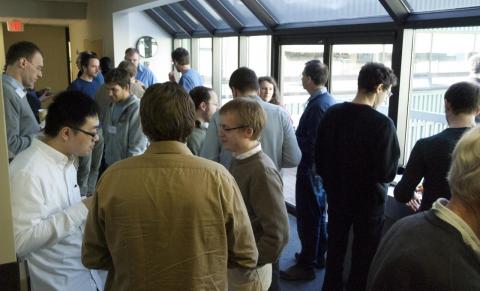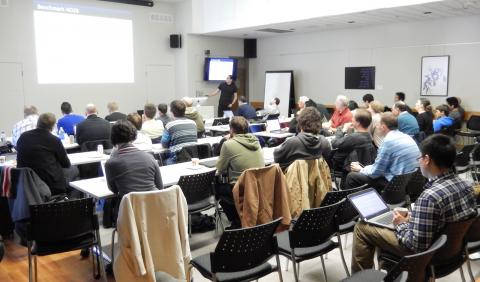

Last week, TRIUMF was buzzing with lively discussion that spilled out of the auditorium and into the hallways. It wasn’t the gold medal hockey game or impending snowfall that had people so captivated, but rather the latest developments in ab initio nuclear structure and reaction calculations. From February 18-21, TRIUMF’s Theory Group hosted the ‘Nuclear Structure and Reactions: Experimental and Ab Initio Theoretical Perspectives’ workshop, organized by Petr Navratil, Sonia Bacca, and Barry Davids. The workshop was attended by forty scientists, most of them working in the field of ab initio nuclear theory, ten from TRIUMF and thirty from institutions across North America and Europe. They gathered to share their latest results, exchange new ideas, and establish new connections.
Beginning as a modest collaboration-style meeting of fifteen people in 2011, the workshop has expanded significantly in size and scope every year. This year, for the first time, there was an experimental component to the workshop, consisting of several talks by leading TRIUMF experimentalists. These talks outlined the experimental efforts in low-energy nuclear physics and astrophysics underway in the ISAC-I and ISAC-II facilities, exploring their connections to ab initio nuclear structure and reaction calculations.
This expansion proved to be a fruitful one. “The workshop helped to develop new collaborations between theory groups and experimentalists,” explains Petr Navratil, a theoretical physicist at TRIUMF. The confluence of theory and experiment also sparked interest in new research areas, giving motivation for scientists to undertake new theoretical calculations and experimental measurements.
The four-day conference was packed with talks that shared the latest research in the field. Among the results presented were the first ab initio calculations for nuclei as heavy as Sn-132, for open shell medium mass nuclei (the masses of which can be measured at TRIUMF), ab initio calculations of cluster states and continuum reactions of O-16, and the first converged ab initio calculations of d-alpha scattering. Looking at these together, an interesting picture emerges: for the first time, ab initio methods for medium mass nuclei have reached an accuracy level that allows scientists to probe the quality of nuclear forces in this mass range.
With this new level of accuracy, it becomes apparent that there are deficiencies in the models of nuclear forces (both two-nucleon and three-nucleon) that are currently in use. In general, these deficiencies lead to over-binding of the medium mass nuclei and underestimating the sizes of these nuclei. The implications of these results will be an important area of inquiry in the future as theorists seek to create a coherent theoretical framework for nuclear structure and reactions.
-Lindsay Kroes, Communications Assistant
